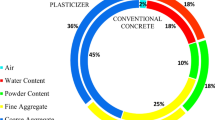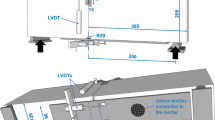Abstract
This paper presents microstructure and flexural behavior of steel-fiber reinforced concrete produced with different steel fibers volume fraction and aspect ratio. Prismatic concrete specimens of 100 × 100 × 350 mm were prepared with and without steel fiber. Two different steel fiber types (both is hooked-end) were used by ratio of 0% (control), 0.2, 0.4, 0.6 and 0.8% by volume. Specimens were de-molded after 24 h and cured in water until 7, 28, 56, 180 and 360 days. On the prisms, flexural strength has been defined for every age. The crack widths have also been measured after maximum bearing loads. Microstructure of SFRC was studied by scanning electron microscopy and optical microscopy for 180 aged specimens. The results showed that the polarized microcopy images may be used for observing the bond characteristic of SFRC as alternatively to SEM. A good bond was observed between steel fiber and concrete matrix interface zone by using polarizing microscopy, too. Flexural strength of SFRC increased with the concrete age and fiber volume fraction. Besides, the first crack development significantly decreased by increasing of fiber volume fraction in the all concrete ages.









Similar content being viewed by others
References
Mohammadi Y, Singh SP, Kaushik SK (2007) Properties of steel fibrous concrete containing mixed fibres in fresh and hardened state. Construct Build Mater (in press). doi: 10.1016/j.conbuildmat.2006.12.004
Yazıcı Ş, İnan G, Tabak V (2007) Effect of aspect ratio and volume fraction of steel fiber on the mechanical properties of SFRC. Construct Build Mater 21(6):1250–1253
Yan A, Wu K, Zhang X (2002) A quantitative study on the surface crack pattern of concrete with high content of steel fiber. Cem Concr Res 32(9):1371–1375
Khaloo AR, Afshari M (2005) Flexural behaviour of small steel fibre reinforced concrete slabs. Cem Concr Compos 27(1):141–149
Ezeldin AS, Balaguru PN (1992) Normal and high-strength fiber-reinforced concrete under compression. Mat Civil Eng 4(4):415–427
Swaddiwudhipong S, Seow PEC (2006) Modelling of steel fiber-reinforced concrete under multi-axial loads. Cem Concr Res 36(7):1354–1361
Gao J, Suqa W, Morino K (1997) Mechanical properties of steel fiber-reinforced, high-strength, lightweight concrete. Cem Concr Compos 19(4):307–313
Shah SP, Rangan BV (1971) Fibre reinforced concrete properties. ACI J 68(2):126–135
Banthia N, Nandakumar N (2003) Crack growth resistance of hybrid fiber reinforced cement composites. Cem Concr Compos 25(1):3–9
Lim DH, Oh BH (1999) Experimental and theoretical investigation on the shear of steel fiber reinforced concrete beams. Eng Struct 21(10):937–944
Bentur A, Diamond S, Mindess S (1985) Microstructure of the steel fibre-cement interface. J Mater Sci 20(10):3610–3620
Chan YW, Chu SH (2004) Effect of silica fume on steel fiber bond characteristics in reactive powder concrete. Cem Concr Res 34(7):1167–1172
Wei S, Mandel JA, Said S (1986) Study of the interface strength in steel fiber-reinforced cement-based composites. ACI J 83(4):597–605
Ramanalingam N, Paramasivam P, Mansur MA et al (2001) Flexural behaviour of hybrid fibre reinforced cement composites containing high volume fly ash. In: Malhotra VM (ed) 7th Canmet/ACI international conference on fly ash, silica fume, slag and natural pozzolans in concrete, SP-199, vol 1, pp 147–61
Chan YW, Li VC (1997) Effects of transition zone densification on fiber/cement paste bond strength improvement. Adv Cem Based Mater 5(1):8–17
Al-Khalaf MN, Page CL (1979) Steel/mortar interface: microstructural features and mode of failure. Cem Concr Res 9(2):197–207
Al-Khalaf MN, Page CL, Ritchie AGB (1980) Effects of fibre surface composition on mechanical properties of steel fibre reinforced mortars. Cem Concr Res 10(1):71–77
Yue L, Shuguang H (2001) The microstructure of the interracial transition zone between steel and cement paste. Cem Concr Res 31(3):385–388
Kayali O (2004) Effect of high volume fly ash on mechanical properties of fiber reinforced concrete. Mater Struct 37(269):318–327
Monteiro PJM, Gjorv OE, Mehta PK (1985) Microstructure of the steel - cement paste interface in the presence of chloride. Cem Concr Res 15(5):781–784
Li VC, Matsumoto T (1998) Fatigue crack growth analysis of fiber reinforced concrete with effect of interfacial bond degradation. Cem Concr Compos 20(5):339–351
ASTM C 293-94, Standard Test Method for Flexural Strength of Concrete (Using Simple Beam with Center-Point Loading) ASTM standards
Topçu İB, Canbaz M (2007) Effect of different fibers on the mechanical properties of concrete containing fly ash. Construct Build Mater 21(7):1486–1491
Author information
Authors and Affiliations
Corresponding author
Rights and permissions
About this article
Cite this article
Uygunoğlu, T. Investigation of microstructure and flexural behavior of steel-fiber reinforced concrete. Mater Struct 41, 1441–1449 (2008). https://doi.org/10.1617/s11527-007-9341-y
Received:
Accepted:
Published:
Issue Date:
DOI: https://doi.org/10.1617/s11527-007-9341-y




